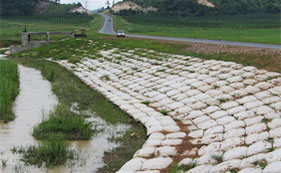
 Back to List
Back to List

Composite geomembrane is a member of a large class of geosynthetics. It is widely used in roads, railways, water conservancy, large buildings, power plant ash dam construction, non-ferrous metal tailings treatment, environmental protection engineering, soil and water conservation and other fields.
The service life of composite geomembrane mainly depends on whether the plastic film loses its anti-seepage and water blocking effects. According to national standards, 0.2 cm thick polyethylene film and stabilizers are used in water conservancy projects under clean water conditions. The service life can reach 40-50 years, and the service life under sewage conditions is 30-40 years. Therefore, the service life of the composite geomembrane is sufficient to meet the requirements of dam seepage prevention.
1. Varieties of composite geomembrane products: one geotextile with one geomembrane, two geotextiles with one geomembrane, multiple geotextiles with multiple geomembranes, and so on.
To
2. the characteristics of composite geomembrane products: integrated anti-seepage drainage, high strength, high friction coefficient, puncture resistance, aging resistance, acid and alkali resistance, and prevent soil erosion.
3. the structure of composite geomembrane: composite geomembrane is to attach geotextiles to one or both sides of the geomembrane to form a composite geomembrane. Its form includes one geotextile and one geomembrane, two geotextiles and one geomembrane, two geomembranes and one geotextile.
Geotextile is used as a protective layer of geomembrane to protect the impermeable layer from damage. In order to reduce ultraviolet radiation and improve anti-aging performance, it is best to use the embedding method.
During construction, sand or clay with a smaller material diameter should be used to level the foundation surface, and then the geomembrane should be laid. The geomembrane should not be stretched too tightly. The part of the soil buried at both ends is corrugated. Finally, use a layer of fine sand or clay on the paved geomembrane with a thickness of 10 cm. Lay a 20-30 cm stone (or precast concrete block) as an impact protection layer. During the construction process, every effort should be made to prevent stones from directly hitting the geomembrane. It is best to construct a protective layer when laying the membrane. The connection between the composite geomembrane and the surrounding structure should be anchored with expansion bolts and steel plate bead, and the connection part should be coated with emulsified asphalt (2mm thick) to prevent leakage.
4. Precautions for composite geomembrane construction:
(1) Must be embedded in use: the thickness of the cover should not be less than 30 cm.
(2) The modified anti-seepage system shall include: buffer layer, anti-seepage layer, transition layer and protective layer.
(3) The soil should be firm to avoid uneven settlement and cracks, and the turf and tree roots in the impervious area should be removed. Spread sand or clay of small diameter on the surface in contact with the membrane as a protective layer.
(4) When laying, the geomembrane should not be stretched too tightly. It is best to bury both ends of the soil in a corrugated shape. Especially when rigid materials are used for anchoring, a certain degree of expansion and contraction should be retained.
(5) During the construction process, avoid stones and heavy objects directly hitting the geomembrane. It is best to place the film while covering the film and cover the film with a protective layer.
5. Joints of composite geomembrane:
The joint treatment of composite geomembrane is a key process, which directly affects the anti-seepage effect. The general seaming methods are: ①Lapping: the width of the lap should be greater than 15cm; ②Thermal welding: suitable for thicker geomembrane substrates, and the width of the lap joint should not be less than 5cm. (Glue is not recommended. Long-term soaking is easy to open the glue, and the anti-seepage effect is poor.)
6. composite geomembrane joint attention:
(1) The combined treatment of composite geomembrane is a key step in construction and directly affects the service life of the project. According to the quality inspection, it is ideal to use thermal welding. (Special glue can also be used for bonding) The heating welding method is to heat the surface of the PE geomembrane, melt it, and then fuse it into a whole by pressure.
(2) Geomembrane is best laid in a certain direction. There is a certain non-adhesive layer of PE film and PET on both sides of the geomembrane. When laying, the direction of the geomembrane of each unit should be adjusted to facilitate the welding of the geomembrane of the two units. ,
(3) After laying the geomembrane, sandbags should be used to prevent wind, and there should be no dust, moisture, dust, etc. at the edge joints.
(4) Before welding, adjust the PE single-layer film on both sides of the joint so that it overlaps a certain wide band, and is flat and wrinkle-free.
(5) When welding, it is best to weld by technicians with certain experience. The welding is done by a special welding machine. Adjust temperature and speed.